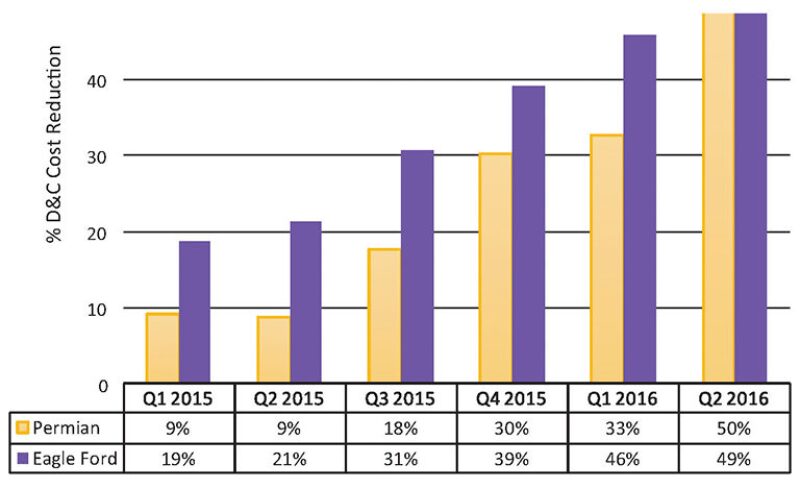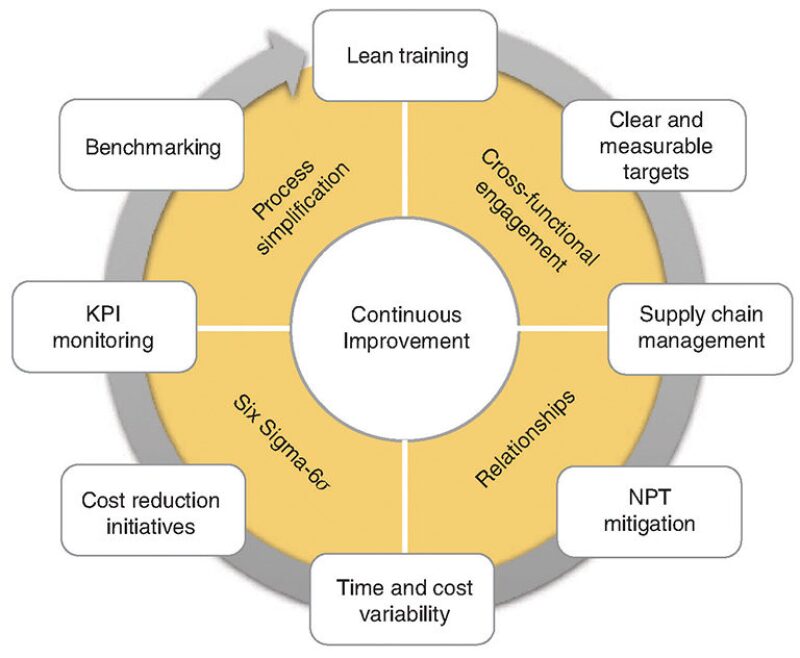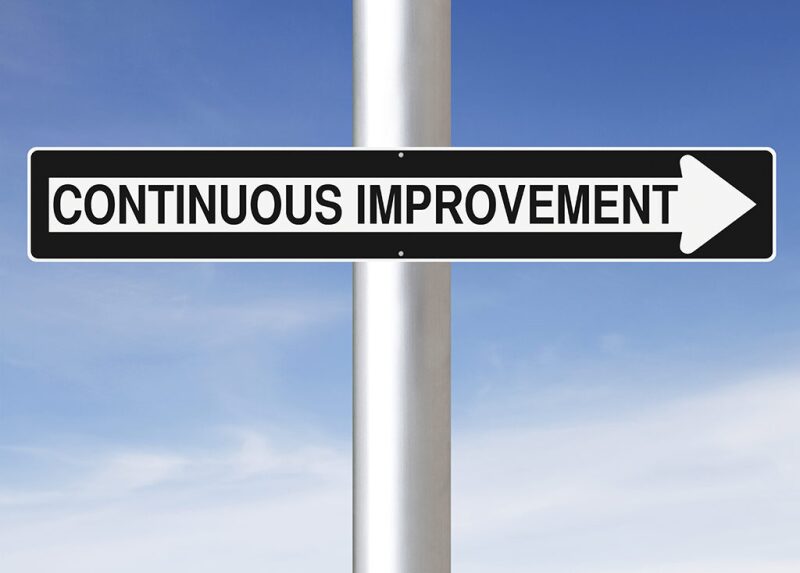The current oil and gas commodity prices have posed several challenges to oil and gas companies operating in shale plays trying to generate revenue or even becoming cash neutral. Shale drilling, as opposed to conventional drilling, requires many more wells to produce similar volumes of oil or gas due to the significantly smaller wellbore drainage area and the tight nature of the reservoir. For these projects to be economically viable, a high volume of low-cost and quickly drilled and completed wells is required, which cannot be achieved with a conventional oil and gas mindset.
By implementing a Lean Well Manufacturing Management System and by having a dedicated Productivity Improvement team embedded in the operations driving changes, BHP Billiton was able to reduce drilling and completion (D&C) costs by 49% in the Eagle Ford Basin and 50% in the Permian Basin over an 18-month period (Fig. 1). These results are similar to those reported by other operators in similar plays that also incorporated lean management principles to their operations.

A Lean Well Manufacturing Management System can be defined as a system to drill and complete a large number of wells per year in a factory-like setting using a lean manufacturing mindset. The performance of the “factory” is measured by the ability to deliver wells at low capital costs while still performing safely, reliably, and meeting local regulatory requirements.
To be successful, this model requires predictable and repeatable performance using highly dependable and fit-for-purpose equipment that is easy to operate and maintain. Value is maximized by addressing the technical specifications from the customer and optimizing the use of existing and new technology to realize the lowest achievable well cost. In turn, this translates into reduction of the unit development costs, increase in short-term production, and more efficient resource utilization.
Waste can be encountered in many areas in the well delivery process, which can increase D&C costs, jeopardizing the project economics. For this reason, the key objective for a lean organization is to identify areas where waste needs to be reduced and eliminated without compromising safety, quality, and performance using the resources (people), processes, and technology available.
For effective implementation, the project should meet certain characteristics. Ideally, the project should be a long-term field development with a continuous drilling program and a large number of wells drilled and completed yearly. The well design should be fit-for-purpose, standardized, and rigs and their components should be specifically selected for the project.
In addition, a dedicated supply organization is required, which should be tasked to resource low-cost and reliable materials, equipment, and consumables, and to make sure they are available “just in time” as required by the operation.
This framework should be supported by a fit-for-purpose business model in which decisions are based on long-term strategies even at the expense of short-term financial goals and the continuity of trained staff tasked to identify ways to push the well delivery boundaries.
Transitioning to a Lean Well Manufacturing Management System requires a fundamental change in the organizational mindset in which every team member should be allowed to challenge any decision in the way the company operates. This is especially difficult in hierarchical organizations where decisions and processes usually cascade from the top. However, this can be overcome by pushing decisions to the appropriate levels and by simplifying the decision-making process to be able to fast-track decisions in response to business needs.
Implementing the System
BHP Billiton’s unconventional basins were ideal candidates to implement a Lean Well Manufacturing System. For this reason, by having full leadership support and adopting lean tools and processes, it was possible to change the company mindset and become a continuous improvement organization. Eight elements contributed to the transformation (Fig. 2).

1. Lean training.
Educating and developing leaders, office, and field personnel in lean methodology was the starting point. Several dedicated training sessions were performed with participation of every key player involved in the well delivery process and projects assigned to put in practice the concepts learned during these sessions.
2. Target definition.
By establishing clear and measurable targets, the D&C organization was able to focus on what was expected in terms of well delivery and quality and start identifying waste in the well delivery process. Regular reviews were performed to track cost reductions and to reset the targets if already met. This provided not only broad understanding of the challenges to overcome but assisted in stretching the goals every time the team exceeded the expectations, which resulted in continuous reduction of D&C costs.
3. Supply chain management.
A dedicated supply organization was assigned to shale operations that assisted in renegotiating contracts and rates as market conditions changed. In addition, it engaged with vendors and suppliers to create an extended partner mindset in which these companies became integral players in the operation and to identify new service providers that could deliver services and goods at lower costs while still meeting the technical and health, safety, and environmental standards required by the ;business.
This helped raising the bar not only in service or materials cost reduction but also to identify technologies available in the market to push the boundaries of performance and created a win-win condition for both companies. The operator benefited from better services and pricing and the service provider by acquiring more market share based on performance improvement.
4. Nonproductive time (NPT) mitigation.
NPT was identified as a major waste contributor in the well delivery process. The expectation was to promote a culture where the organization was capable of identifying failures in the well manufacturing process before they occurred.
A series of tools and processes were developed to prevent and minimize NPT. For example, quality control and quality assurance processes and field inspection for all tools were sent to site to prevent downhole failure, field investigations were performed every time equipment failed or performed inadequately, after-action reviews were done every time an unplanned event occurred, and backup tools were available on site for all critical rig components to minimize downtime. Learnings associated with unplanned events were captured and shared with all team members across both basins to accelerate the operational learning curve and prevent similar failures.
5. Time and cost variability reduction.
As wells were drilled in a factory-like setting following a standardized design with repetitive operational activities and phases, time and cost variability was reduced. Statistical tools were developed to promote discussions between field and office personnel to identify time and cost variations in the well delivery process and to take corrective actions as required.
The main objective for developing, promoting, and having these tools accessible to all team members was to have a systematic way to classify and display time and cost data for several users simultaneously, and substantially reduce recurrent data processing tasks so decisions could be fast-tracked based on actual information. In addition, these tools allowed quality checks on data entered into the database that could mislead decisions if operations were improperly coded. These applications were developed using data visualization and analytics software and were linked in real time to the daily drilling reporting database.
6. Cost reduction initiatives and projects.
An integral component of D&C cost reduction was to develop a system that allowed capturing and ranking every single cost reduction idea and initiatives generated, and by adopting a methodology that allowed achieving stable and predictable results upon project implementation.
From April 2015 to date, more than 1,000 ideas have been captured, many of which came from the forefront of the operation (e.g., roughnecks and derrick hands). Although not all the ideas have been implemented, all ideas were analyzed, ranked, and recorded for potential future implementation.
At some work sites, a recognition system was implemented where the best ideas were announced and the contributor rewarded, which helped boost the number of additional ideas as well as morale.
Six Sigma was the methodology adopted by the organization to create consistency and sustainability in project implementation. Six Sigma is a set of techniques and tools for process improvement that eliminates defects and reduces variability in the manufacturing process. When combined with lean (Lean Six Sigma), the organization benefited not only by removing waste from the well manufacturing process but also achieved accurate results by reducing variability.
Each project had a specific value driver (e.g., reduce cycle time, reduce spend, increase production) and followed a defined sequence of steps (define, measure, analyze, improve, and control), which assisted implementing the solution or process change. During project execution, any changes that could deviate from company standards or policies were risk-assessed, approved, and communicated through a management of change system so well integrity and safety were not compromised at the expense of reducing well costs.
7. Key performance indicator (KPI) monitoring.
To continuously evaluate performance and to promote a learning organization culture, a functional and visible system was developed to monitor performance improvements based on a group of functional KPIs. This system analyzed the entire operation at various levels of granularity and provided visibility to the entire D&C organization on how the team was performing.
8. Benchmarking.
Lastly, an internal benchmark system was adopted to compare performance between rigs operating in different basins and establish an external benchmark system to compare BHP Billiton’s performance against competitors’.
Preparing for the Upturn
Regardless of market conditions, if a Lean Well Manufacturing System is implemented correctly, efficiency gains can be sustained as waste is removed and variability reduced from the well manufacturing process, allowing for delivery of predictable and repeatable performance. This can only take place if learnings from initiatives and process changes are properly documented. In addition, a mentoring system should take place in which experienced personnel transfer operational knowledge to new personnel so consistency and performance continuity are assured. The D&C organization has to be flexible to adapt to new market conditions and incorporate new tools or systems to prevent performance slippage once additional rigs are incorporated in the operation.
Carlos Bossi, SPE, joined BHP Billiton in 2013 and works as a senior drilling engineer leading the productivity improvement transformation process for North America shale. He holds an MSc degree in well design and engineering with distinction from Robert Gordon University in Aberdeen, Scotland, and a BSc degree in mechanical engineering from the Universidad Simón Bolívar in Caracas, Venezuela.

